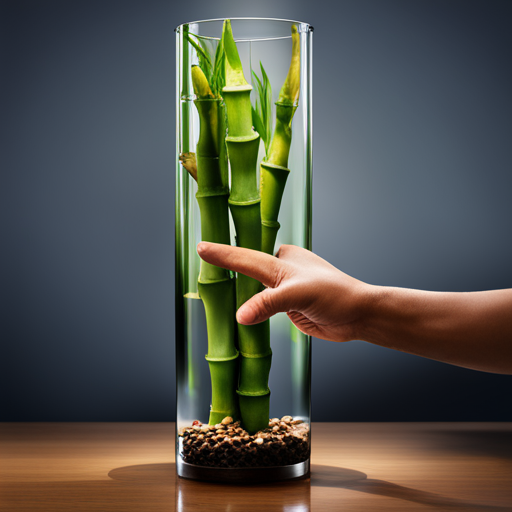To ensure proper growth, it is essential to bury the plant at a depth of 3 to 4 inches. Tap water, containing fluoride that is toxic to lucky bamboo, should be avoided, and filtered or bottled water should be used as an alternative.
The root end of the plant should be submerged in water, while the stalks should remain above the water level. Promoting water circulation around the roots can be achieved by utilizing stones or pebbles.
Lucky bamboo is relatively low-maintenance and can thrive solely in water, utilizing waste from the fish as a source of nutrients. However, preventing root decay is crucial, as it can release toxins harmful to the fish. Contrary to popular misconceptions, lucky bamboo does not release toxins into the tank water.
Contents
- 1 Our Highlighted Points
- 2 How to Submerge Lucky Bamboo
- 3 Water Requirements for Lucky Bamboo
- 4 Myths and Facts about Lucky Bamboo
- 5 Can Lucky Bamboo in a Fish Tank Harm Cats if Ingested?
- 6 Frequently Asked Questions
- 6.1 Can lucky bamboo be placed in a fish tank with saltwater fish?
- 6.2 Will lucky bamboo survive in a fish tank with low lighting conditions?
- 6.3 Can lucky bamboo be placed in a fish tank with live plants?
- 6.4 Is it necessary to fertilize lucky bamboo in a fish tank?
- 6.5 Can lucky bamboo be placed in a fish tank with a heater?
Our Highlighted Points
- Lucky bamboo can be partially or fully submerged in water in a fish tank.
- The roots of lucky bamboo should be submerged in the water of the fish tank.
- Lucky bamboo adds sophistication to any fish tank and can be kept in small and large tanks.
How to Submerge Lucky Bamboo

Submerging lucky bamboo in a fish tank involves burying its roots at a depth of 3 to 4 inches and ensuring that the root end is submerged in water while the stalks remain above the water surface. This planting technique allows the lucky bamboo to thrive in an aquatic environment, despite not being a true aquatic plant.
The benefits of incorporating lucky bamboo in a fish tank are numerous. It adds a touch of sophistication to the tank and can be easily grown in both small and large aquariums. Lucky bamboo also efficiently lowers nitrates in the tank, providing a healthier environment for the fish. Additionally, waste from the fish can serve as a natural source of nutrients for the lucky bamboo, making it a mutually beneficial arrangement.
Water Requirements for Lucky Bamboo

When considering the water requirements for lucky bamboo in an aquatic environment, it is important to ensure proper water circulation around the roots.
The water quality plays a crucial role in the proper care of lucky bamboo. Tap water, which often contains fluoride, can be detrimental to the plant’s health. Therefore, it is recommended to use filtered or bottled water to avoid any potential toxicity.
Additionally, stagnant or compacted substrate water can cause issues for lucky bamboo in the fish tank. To address this, stones or pebbles can be used to promote water circulation around the roots.
It is important to note that lucky bamboo does not require any special additions to the fish tank, as waste from the fish can provide the necessary nutrients.
By maintaining a suitable water quality and ensuring proper care, lucky bamboo can thrive in an aquatic environment.
Myths and Facts about Lucky Bamboo

Misconceptions regarding the care and suitability of lucky bamboo in aquatic environments persist. While lucky bamboo can thrive when partially or fully submerged in water, there are both pros and cons to using it in fish tanks.
One common misconception is that lucky bamboo releases toxins into the tank water. However, this is not true. Lucky bamboo does not release any harmful substances that can harm the fish. On the contrary, it can actually help to lower nitrates in the water, improving the overall water quality for the fish.
Another misconception is that lucky bamboo requires special additions to the tank. In reality, lucky bamboo can survive in water alone and does not need any additional supplements. However, it is important to use filtered or bottled water instead of tap water, as the fluoride in tap water can be toxic to the plant.
Overall, lucky bamboo is a suitable and beneficial addition to fish tanks, providing aesthetic appeal and potentially improving water quality.
Can Lucky Bamboo in a Fish Tank Harm Cats if Ingested?
Having lucky bamboo and cats together in a fish tank can be risky. If ingested, lucky bamboo can be harmful to cats, causing symptoms like vomiting and gastrointestinal distress. Keep the plant out of your cat’s reach to avoid potential health issues.
Frequently Asked Questions
Can lucky bamboo be placed in a fish tank with saltwater fish?
Lucky bamboo can be placed in a fish tank with saltwater fish. However, the compatibility of lucky bamboo with fish tank lighting should be considered, as excessive or inadequate lighting can affect the growth and overall health of the plant.
Will lucky bamboo survive in a fish tank with low lighting conditions?
Lucky bamboo can survive in a fish tank with low lighting conditions. It requires placement in the tank and proper care, including regular watering and the use of artificial lighting to compensate for the lack of natural light.
Can lucky bamboo be placed in a fish tank with live plants?
Lucky bamboo can be placed in a fish tank with live plants as it is compatible with different species. It has no negative impact on water quality and can coexist harmoniously, enhancing the aesthetic appeal of the tank.
Is it necessary to fertilize lucky bamboo in a fish tank?
Fertilizing techniques for lucky bamboo in a fish tank are not necessary as it can survive solely on fish waste as a nutrient source. The benefits of lucky bamboo in a fish tank include its ability to lower nitrates and add aesthetic appeal.
Can lucky bamboo be placed in a fish tank with a heater?
Lucky bamboo can be placed in a fish tank with a heater as long as the water temperature remains within the suitable range for both the fish and the plant. Heater compatibility should be considered to maintain optimal conditions.

